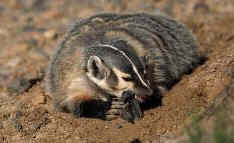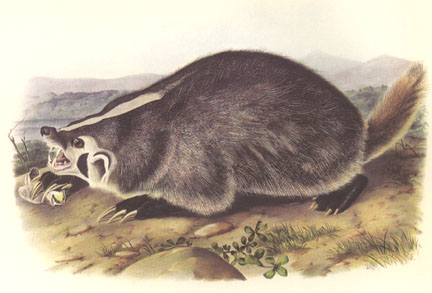American Badger The American badger is not closely related to its European counterpart, and lives a very different lifestyle. While the European badger digs deep warrens that may be used without interruption for decades, the American badger is a vagrant that moves across the landscape, digging a new burrow every day or two. While the sette of a European badger may be a cavernous maze of den pipes, the American badger is more likely to dig a one-eyed sette that extends just 15 to 30 feet into a bank. In the United States, the American badger is found from the west coast to Texas, Oklahoma, Missouri, Illinois, Ohio, Michigan and Indiana. It is also found in southern Canada in British Columbia, Manitoba, Alberta and Saskatchewan. In general, badgers are not found in areas where there is a lot of cultivation or a lot of trees. A typical habitat is the undisturbed and treeless area of a prairie, mountain meadow, or scrub desert. The American badger is a large, tough and ferocious weasel, with adults weighing between 10 and 40 pounds. The badger has few natural enemies. With their low-slung bodies, powerful jaws and tough claws, they are almost impossible to knock over and are quick to inflict bone-crushing damage to anything that tries. Their thick skin is difficult to pierce, and is so loose that even when grabbed, they can easily turn to deliver a powerful bite to their opponent. Dogs that move in to tackle a badger head-to-head will be lucky if they live to regret it. Badgers are digging machines. Their very life depends on their ability to move soil rapidly as their primary food source are small burrowing rodents like ground squirrels, rats, gophers, chipmunks and mice. Coyotes will often stand by while badgers are burrowing, in order to catch fleeing rodents as they try to escape. While the main staple of a badger diet is rodents, they will also eat snakes, birds, insects, carrion, eggs, lizards, insects and beetle grubs. The badger was once fairly common throughout the open grassland of North America, but with the extermination of large prairie dog towns, their numbers began to decline. Consumption of poisons left out for coyotes has further reduced their numbers in some areas, and badgers are routinely hit by cars as they scavenge for road-kill carrion. That said, the badger population in North America is stable and perhaps increasing due to the proliferation of ground squirrels in the American west. When threatened, the American badger releases a strong musky odor as a warning, and this musky smell permeates its flesh, which most animals find inedible. Badgers are forced into a nomadic life because they are such efficient eradicators of rodents that they can deplete local populations rather quickly. A badger can travel five to eight miles a night, leaving behind it a trail of freshly dug burrows that will later be used as dens by coyotes, tortoises, snakes, skunks and owls. Badgers are largely solitary and almost entirely nocturnal, foraging at night and then remaining underground during the daylight hours. While the den hole of a red fox is generally taller than it is wide, a badger will dig a hole that is 8 to 12 inches in diameter and elliptical -- i.e. wider than it is tall. Soil excavated during the digging of the den is piled at the entrance. During very cold weather, a badger will partially plug the den with soil to keep out water and help retain heat. The badger does not hibernate, however, and can be found foraging all winter long. Badgers mate in late summer, but the fetus does not begin to grow until February, and the pups are born in March or April. Between one and five pups will be whelped, each covered in light fur. The pups grow quickly, and will be weaned at about eight weeks of age. By August, they will be on their own.
American Badger by John James Audubon
|

